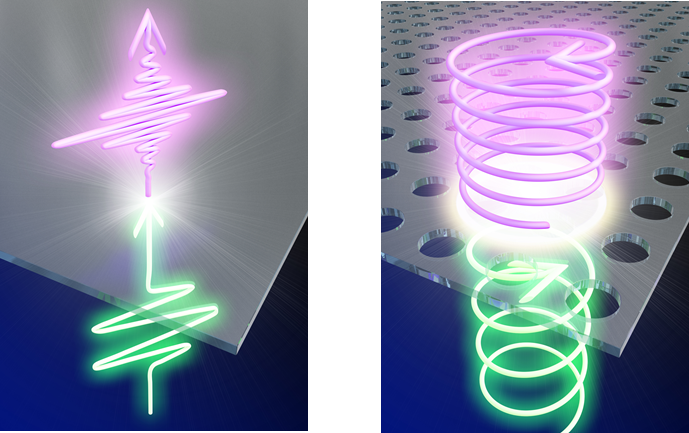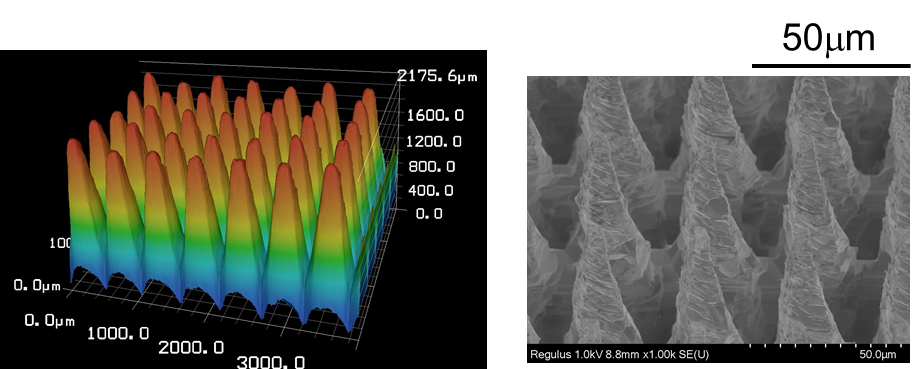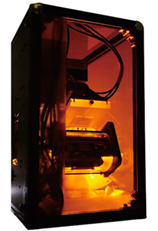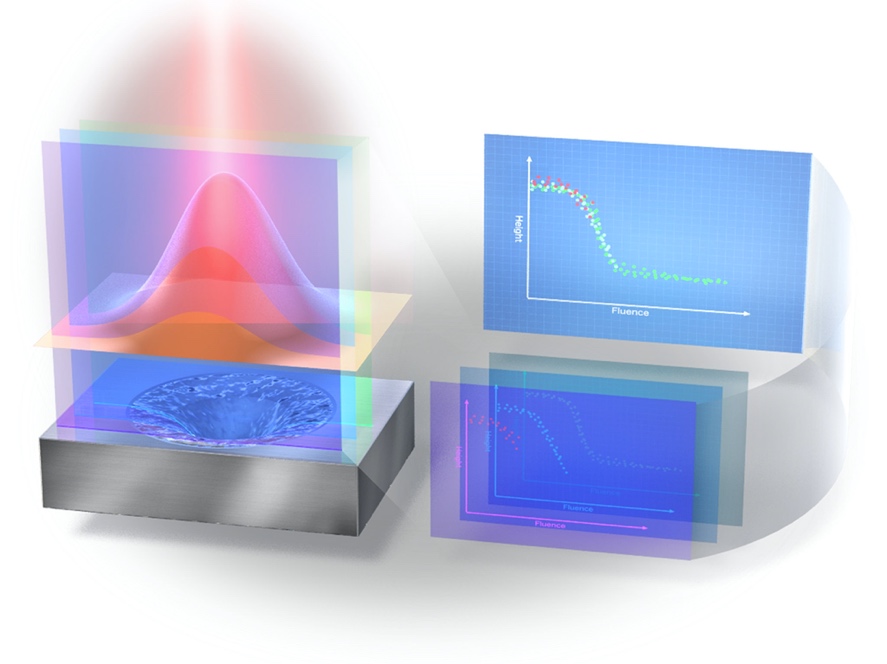Policy
We are investigating new physical phenomena caused by the interaction of light with nano- and micro-scale ultra-fine artificial structures fabricated by state-of-the-art microfabrication techniques, and their application to optical control. Furthermore, based on condensed matter physics, we are exploring the scientific principles of laser processing to understand why light can break things, and are developing new methods for fabricating micro three-dimensional structures using state-of-the-art ultrashort pulsed lasers.
As a member of UTokyo Research Institute for Photon Science and Laser Technology, we are also working to create a new system for the rapid transfer of new technologies created by our laboratory to the real industry.
Research topics
- Exploration of new phenomena and their physics of artificial nanostructures and its application to optical control
- Creation of micro three-dimensional structures by ultrashort pulse laser and their application to electromagnetic wave control
- Elucidating the Principles of Laser Processing
Exploration of new phenomena and their physics of artificial nanostructures and its application to optical control
The gate lengths of transistors in semiconductor chips, which have become indispensable to modern society, have now been miniaturized to the order of several tens of nanometers. On the other hand, the wavelength of visible light is approximately 380 nm to 780 nm. This means that we already have the ability to fabricate structures much smaller than the wavelength of light in metals and semiconductors at will. Artificial nanostructures that are smaller than the wavelength of light can be used to create new physical phenomena and to control light based on the new concept of manipulating the interaction with light through the “shape” of appropriately designed nanostructures.We are exploring new phenomena in such artificial nanostructures, elucidating their mechanisms, and applying them to light sources. In particular, we are aiming to apply our light source to the vacuum ultraviolet region with wavelengths below 200 nm and terahertz waves with frequencies near 1 THz, which are in need of development of control methods.

Published papers:
- Optical Fresnel zone plate flat lenses made entirely of colored photoresist through an i-line stepper
Ryohei Yamada, Hiroyuki Kishida, Tomohiro Takami, Itti Rittaporn, Mizuho Matoba, Haruyuki Sakurai & Kuniaki Konishi
Light: Science & Applications 14, 43 (2025) - Finite-Area Membrane Metasurfaces for Enhancing Light-Matter Coupling in Monolayer Transition Metal Dichalcogenides
Ya-Lun Ho, Chee Fai Fong, Yen-Ju Wu, Kuniaki Konishi, Chih-Zong Deng, Jui-Han Fu, Yuichiro K. Kato, Kazuhito Tsukagoshi, Vincent Tung, Chun-Wei Chen
ACS Nano 18, 241173 (2024) - Circularly polarized vacuum ultraviolet coherent light generation using a square lattice photonic crystal nanomembrane
Kuniaki Konishi, Daisuke Akai, Yoshio Mita, Makoto Ishida, Junji Yumoto, Makoto Kuwata-Gonokami
Optica 7, 855 (2020) - Tunable third harmonic generation in the vacuum ultraviolet region using dielectric nanomembranes
Kuniaki Konishi, Daisuke Akai, Yoshio Mita, Makoto Ishida, Junji Yumoto, Makoto Kuwata-Gonokami
APL Photonics 5, 066103 (2020)
selected as Featured Article and highlighted by AIP Scilight
Reviews:
- Tunable and nonlinear metamaterials for controlling circular polarization
Kuniaki Konishi, Tetsuo Kan, Makoto Kuwata-Gonokami
Journal of Applied Physics 127, 230902 (2020)
Research Introduction Video:
Press release:
Creation of micro three-dimensional structures by ultrashort pulse laser and their application to electromagnetic wave control
It is a well-known fact that when a material is exposed to intense laser light, the material is dRecent advances in laser technology have made it possible to generate intense and stable ultrashort pulsed lasers that can not only drill and cut objects, but also fabricate micron-order fine three-dimensional (3D) structures that are difficult to fabricate by other methods. On the other hand, the 3D printer using laser light developed by the Photon Science Institute is attracting attention as a bottom-up technology for fabricating micron-order fine 3D structures, and is a complementary technology to laser processing. Since the structures fabricated by such advanced technology are smaller than electromagnetic waves such as millimeter wave and terahertz wave, they can be utilized as functional materials for new electromagnetic wave control by fabricating appropriate structures. In this research, we are developing such laser-based 3D structure fabrication technology and at the same time developing new functional materials using such technology, and we recommend its application to various fields such as astrophysics and next-generation wireless technology (Beyond 5G).


Published papers and press release:
〈 Fabrication of fine 3D structures using femtosecond lasers 〉
- Carbon-Coated Moth-Eye Structure: An Ultrabroadband THz-DUV Near-Perfect Absorber
Yuki Hakamada, Maria Cojocari, Mizuho Matoba, Shotaro Kawano, Haruyuki Sakurai, Kuniaki Konishi*, Daniil Pashnev, Surya Revanth Ayyagari, Vytautas Janonis, Andrzej Urbanowicz, Saulius Tumėnas, Justinas Jorudas, Irmantas Kašalynas*, Janna Pennanen, Adigun Deborah Amos, Aleksandr Saushin, Georgy Fedorov*, Yuri Svirko, Polina Kuzhir
Advanced Optical Materials (2025) https://doi.org/10.1002/adom.202500948
2025/6/12
“Ultra-broadband full absorber with carbon-coated moth-eye structure“ - Deep-Ultraviolet AlN Metalens with Imaging and Ultrafast Laser Microfabrication Applications
Yu Chieh Peng, Yu Jie Wang, Kuan-Heng Chen, Yu Hung Lin, Haruyuki Sakurai, Hsueh-Chih Chang, Cheng-Ching Chiang, Ruei-Tzu Duh, Bo-Ray Lee, Chia-Yen Huang, Min-Hsiung Shih, Ray-Hua Horng
Kuniaki Konishi*, Ming Lun Tseng*
Nano Letter 25, 3141 (2025) - Broadband laser-processed terahertz moth-eye antireflection structure with a controlled lattice type
Rikuo Koike, Mizuho Matoba, Shotaro Kawano, Haruyuki Sakurai, Kuniaki Konishi, Norikatsu Mio
Applied Optics 63, 7442 (2024) Selected as Editor’s Pick - Laser processing of silicon with GHz burst pumped third harmonics for precise microfabrication
Haruyuki Sakurai and Kuniaki Konishi
Optics Express 31, 40748 (2023) - 2022/1/27
“Scientists Make a New Type of Optical Device Using Alumina” - A Large Diameter Millimeter-Wave Low-Pass Filter Made of Alumina with Laser Ablated Anti-Reflection Coating
Ryota Takaku, Qi Wen, Scott Cray, Mark Devlin, Simon Dicker, Shaul Hanany, Takashi Hasebe, Teruhito Iida, Nobuhiko Katayama, Kuniaki Konishi, Makoto Kuwata-Gonokami, Tomtoake Matsumura, Norikatsu Mio, Haruyuki Sakurai, Yuki Sakurai, Ryohei Yamada, Junji Yumoto
Optics Express 29, 41745-41765 (2021) - Broadband, millimeter-wave anti-reflective structures on sapphire ablated with femto-second laser
R. Takaku, S. Hanany, H. Imada, H. Ishino, N. Katayama, K. Komatsu, K. Konishi, M. Kuwata-Gonokami, T. Matsumura, K. Mitsuda, H. Sakurai, Y. Sakurai, Q. Wen, N. Y. Yamasaki, K. Young, J. Yumoto
Journal of Applied Physics 128, 225302 (2020) - Terahertz broadband anti-reflection moth-eye structures fabricated by femtosecond laser processing
Haruyuki Sakurai, Natsuki Nemoto, Kuniaki Konishi, Ryota Takaku, Yuki Sakurai, Nobuhiko Katayama, Tomotake Matsumura, Junji Yumoto, Makoto Kuwata-Gonokami
OSA Continuum 2, 2764 (2019)
Editor’s Pick
〈 Fabrication of elements for terahertz control using an ultra-high definition 3D printer 〉
- Suitability of metallic materials for constructing metal-coated dielectric terahertz waveguides
Yuyuan Huang, Kuniaki Konishi, Momoko Deura, Yusuke Shimoyama, Junji Yumoto, Makoto Kuwata-Gonokami, Yukihiro Shimogaki, Takeshi Momose
Journal of Applied Physics 131, 105106 (2022) - Development of a model for evaluating propagation loss of metal-coated dielectric terahertz waveguides
Yuyuan Huang, Kuniaki Konishi, Momoko Deura, Yusuke Shimoyama, Junji Yumoto, Makoto Kuwata-Gonokami, Yukihiro Shimogaki, Takeshi Momose
Journal of Applied Physics 130, 055104 (2021) - 3D printed 1.1 THz waveguides
W. J. Otter, N. M. Ridler, H. Yasukochi, K. Soeda, K. Konishi, J. Yumoto, M. Kuwata-Gonokami, S. Lucyszyn
Electronics Letters 53, 471 (2017)
Elucidating the Principles of Laser Processing
It is a well-known fact that when a material is exposed to intense laser light, the material is destroyed, and in fact, laser processing is an important fundamental technology that supports current industry. On the other hand, the mechanism by which ultrashort laser pulses in particular cause material destruction remains unclear. When intense pulsed light that causes material destruction is incident on a material, what kind of process is used to transfer the energy of the light to the material? How does this energy propagate through the electron and lattice systems inside the material, and what triggers the dramatic and irreversible phenomenon of destruction? To find answers to these questions, we have developed state-of-the-art optical control techniques and various measurement methods, and are conducting research by making full use of these techniques. Through this research, we aim not only to elucidate the mechanism of laser-induced material destruction, but also to use this knowledge to further advance laser processing technology.
In addition, we encourage collaboration with the activities of several national projects to rapidly transfer new technologies created in the laboratory to the real world.

Published papers and Press release:
- Carbon-Coated Moth-Eye Structure: An Ultrabroadband THz-DUV Near-Perfect Absorber
Yuki Hakamada, Maria Cojocari, Mizuho Matoba, Shotaro Kawano, Haruyuki Sakurai, Kuniaki Konishi*, Daniil Pashnev, Surya Revanth Ayyagari, Vytautas Janonis, Andrzej Urbanowicz, Saulius Tumėnas, Justinas Jorudas, Irmantas Kašalynas*, Janna Pennanen, Adigun Deborah Amos, Aleksandr Saushin, Georgy Fedorov*, Yuri Svirko, Polina Kuzhir
Advanced Optical Materials (2025) https://doi.org/10.1002/adom.202500948 - Simulation of nonlinear propagation of femtosecond laser pulses in air for quantitative prediction of the ablation crater shape
Ryohei Yamada, Wataru Komatsubara, Haruyuki Sakurai, Kuniaki Konishi, Norikatsu Mio, Junji Yumoto, and Makoto Kuwata-Gonokami
Optics Express 31, 7363 (2023) - Pulse-to-pulse ultrafast dynamics of highly photoexcited Ge2Sb2Te5 thin films
Masataka Kobayashi, Yusuke Arashida, Kanta Asakawa, Keisuke Kaneshima, Masashi Kuwahara, Kuniaki Konishi, Junji Yumoto, Makoto Kuwata-Gonokami, Jun Takeda, Ikufumi Katayama
Japanese Journal of Applied Physics 62 , 022001 (2023) - 2021/03/29
“Laser lights the way – A new way to observe laser interactions could improve laser-based manufacture- ” - Direct correlation of local fluence to single-pulse ultrashort laser ablated morphology
Haruyuki Sakurai, Kuniaki Konishi, Hiroharu Tamaru, Junji Yumoto, Makoto Kuwata-Gonokami
Communications Materials 2,38 (2021) - Direct writing of optical waveguide in fused silica by fundamental beam of Yb:KGW femtosecond laser
Ryo Imai, Kuniaki Konishi, Junji Yumoto, Makoto Kuwata-Gonokami
OSA Continuum 4, 1,000-1009 (2021) - Effect of damage incubation in the laser grooving of sapphire
Haruyuki Sakurai, Chao He, Kuniaki Konishi, Hiroharu Tamaru, Junji Yumoto, Makoto Kuwata-Gonokami, Arnold Gillner
Journal of Applied Physics 125, 173109 (2019)